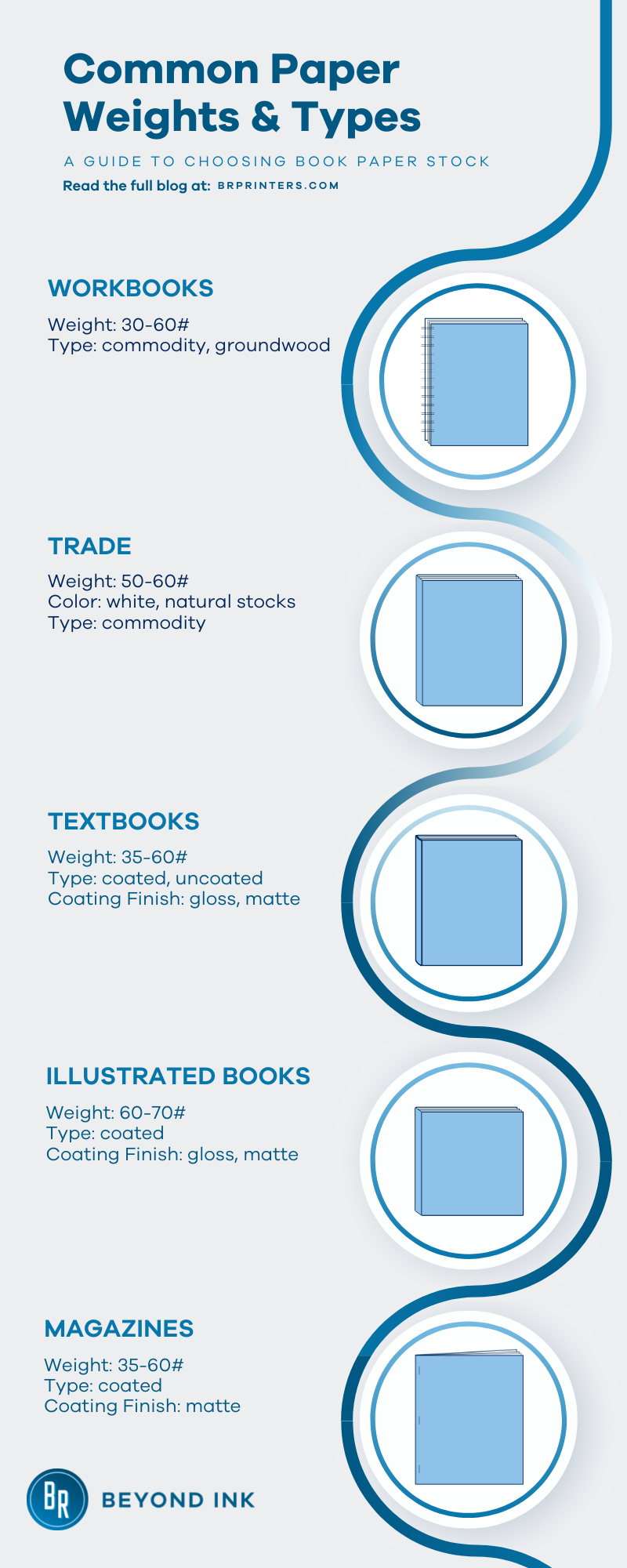Complete Guide for Choosing Book Paper
Looking for a complete guide to choosing the best paper stock for your book? Here we’ll help you gain some clarity in your decision-making process by reviewing the basic paper terms, identifying common book paper specs, and diving into the other factors publishers and printers consider when printing books. Guiding publishers toward the best printing decisions for their books is what we do every day here at BR Printers. Now it’s our turn to help you!
Basic Paper Terms
To choose the best paper for your book, you’ll need to understand the following terms. These are specs that specify differences between types of paper.
Brightness: the papers’ contrast, brilliance, and reflectance
Color: the paper’s shade of white varies between warm and cool shades
Opacity: how much the printed content on a page shows through on the other side of the paper
Paper Weight: how much a standard 500-sheet ream weights
PPI: number of pages per inch (PPI)
Groundwood: a recycled uncoated paper stock made from a pulp converted from wood and has a yellowish color. Primarily used in magazines, newspaper inserts, and catalogs.
Commodity/Freesheet: an uncoated paper stock free of groundwood which makes the paper a bright white color and increases the longevity of the paper. Freesheet has a very high opacity and bulk, resulting in thicker-looking books. Primarily used for business collateral such as reports, brochures, advertising materials, and catalogs. This paper lasts longer than other paper stocks
Coated: the paper type where the paper is sealed by a type of clay coating which produces prints with sharp definition, improved density, and greater color fidelity than uncoated papers. Coated paper is generally matte, gloss, or silk
Common Paper Weights & Types
Workbooks
- Weight: 30-60#
- Type: commodity & groundwood
Trade
- Weight: 50-60#
- Color: White and natural (cream) stocks
- Type: commodity
Textbooks
- Weight: 35-60#
- Type: coated and uncoated
- Coating Finish: gloss and matte
Illustrated Books
- Weight: 60-70#
- Type: coated
- Coating Finish: gloss and matte
Magazines
- Weight: 35-60#
- Type: coated
- Coating Finish: matte
Not seeing the type of book you’re looking for? Message us today and we can give you the most accurate, detailed, and current information about the paperweight, type, color, and coating for your book.
Choose the Best Paper for Your Book
Cost, appearance, and availability are important factors when choosing a paper stock.
For example, if a publisher is selecting PPI, they should consider their budget for shipping costs because low PPI paper can keep shipping costs low. That publisher should also evaluate the length of their book. Does my book have a high page count? “Low PPI paper is good for high page count books to get in one volume,” says John Edwards, BR Printers East President. Does my book have a low page count? Edwards explains that a “high PPI means a low page count book will bulk higher and look thicker and look better on the shelf.” The availability of high or low ppi book paper is fluctuating constantly, which can impact the speed of your book printing process.
Along with PPI, you’ll have to choose which type of paper you want. In the basic paper terms section, you’ll find a few of the different types of paper: commodity/freesheet, groundwood, and coated. Typically, the most expensive type of paper is coated and the least expensive is groundwood.
The different types of paper coating finishes are mentioned in the basic paper terms above: matte, silk, and gloss. For paper coating, prices vary based on quality. The coating finish determines the vibrancy of the colors and shiny finish.
Like PPI, the availability of different paper and coated stock fluctuates. According to Steve Duvanich, BR Printers Director of Enterprise Sales, “your mattes, your silks, your glosses are still going to be supply chain challenged over the next couple years.” This uncertainty means collaboration with your printer is your best strategy for selecting the best coating finishes for your book.
Once your paper is chosen and printed, it’ll need to be bound. Book binding is the final step in the book printing process and, like paper type, the different book binding types can add to the functionality and appearance of your book.
Partner With Printing Experts at BR Printers
Bringing books from the first draft to the readers’ hands is not an easy task. It takes industry knowledge, experience, and connections to bring these books to life. As a publisher, your book printer should be your strategic partner. Their understanding and knowledge of book manufacturing can help you make the best decisions for your book printing.
BR Printers started as an educational and trade printer in San Jose, CA but now we’ve diversified our capabilities and national footprint. We’re happy to be based in San Jose, CA with facilities in San Diego, CA, Denver, CO, Appleton, WI, Cincinnati, OH, and Independence, KY, BR is now a provider of high-quality large format printing, commercial printing, labels, marketing, value chain, and logistics management to marketers and the publishing industry’s most recognizable names. Let us help you! Contact us today.
